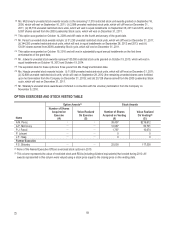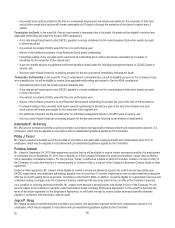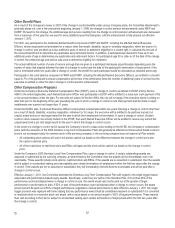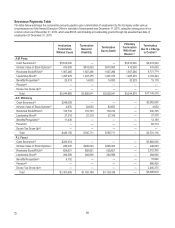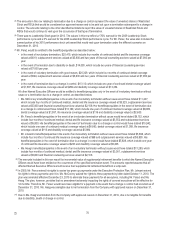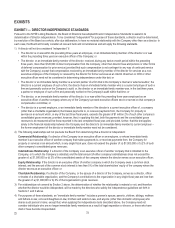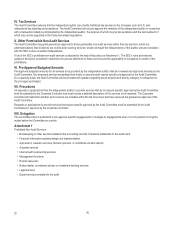Kodak 2010 Annual Report Download - page 193
Download and view the complete annual report
Please find page 193 of the 2010 Kodak annual report below. You can navigate through the pages in the report by either clicking on the pages listed below, or by using the keyword search tool below to find specific information within the annual report.
67
Other Benefit Plans
As a result of the Company’s review in 2007 of the change in control benefits under various Company plans, the Committee determined to
gradually phase out, over a five-year period beginning January 1, 2008, the change in control pension enhancements under KRIP and
KURIP. Pursuant to this change, the additional age and service resulting from the change in control pension enhancement was decreased
from a maximum of five years by one year for every additional year that transpires, until the enhancement is fully phased out effective
January 1, 2012.
For 2010, any participant in the traditional defined benefit component of KRIP and KURIP, including the affected Named Executive
Officers, whose employment is terminated for a reason other than death, disability, cause or voluntary resignation, within two years of a
change in control, was provided up to two additional years of service to determine eligibility for a vested right, to calculate the amount of
the accrued benefit and to determine any applicable early retirement factors. In addition, a participant was deemed to have up to two
additional years of age in determining any applicable early retirement factors. For participants age 50 or older as of the date of the change
in control, the enhanced age and service was used to determine eligibility for retirement.
The actual additional number of years of service and age that are given to a participant decreases proportionately depending upon the
number of years that elapsed between the date of a change in control and the date of the participant’s termination of employment. If the
plan is terminated within two years after a change in control, the benefit for each participant would be calculated as indicated previously.
Participants in the cash balance component of KRIP and KURIP, including the affected Named Executive Officers, are entitled to a benefit
equal to 7% of the participant’s annual compensation at the time of the termination times the number of additional years of service that the
executive is entitled to under the plan’s change in control pension enhancement.
Other Compensation Programs
Under the Company’s Executive Deferred Compensation Plan (EDCP), upon a change in control (as defined in EDCP and by Section
409A to the extent applicable), each Named Executive Officer who participates in EDCP will be entitled to a lump-sum cash payment of his
or her account balance under the plan. For amounts not subject to Section 409A, this rule will not apply if the executive elects in writing no
later than prior to the beginning of the year preceding the year in which a change in control occurs that payment shall be made in equal
installments over a period not longer than 11 years.
Under the EXCEL plan, if a Named Executive Officer’s employment is terminated within two years following a change in control other than
as a result of death, disability, voluntary resignation, retirement or for cause, the executive will be entitled to be paid any earned, but
unpaid, award and a pro rata target award for the year in which their employment is terminated. If, upon a change in control, Kodak’s
common stock ceases to be actively traded on the NYSE, then each Named Executive Officer will be entitled to receive any earned but
unpaid award and a pro rata target award for the year in which the change in control occurs.
In the event of a change in control which causes the Company’s stock to cease active trading on the NYSE, the Company’s compensation
plans (with the exception of the 2005 Omnibus Long-Term Compensation Plan) will generally be affected as follows when Kodak common
stock is not exchanged solely for common stock of the surviving company or the surviving company does not assume all Plan awards:
• All outstanding stock options will vest in full and be cashed out based on the difference between the change in control price and
the option’s exercise price.
• All of the restrictions on restricted stock and RSUs will lapse and the stock will be cashed out based on the change in control
price.
Under the Company’s 2005 Omnibus Long-Term Compensation Plan, upon a change in control, if certain outstanding awards are
assumed or substituted by the surviving company, as determined by the Committee, then the awards will not immediately vest or be
exercisable. These awards include stock options, restricted stock and RSUs. If the awards are so assumed or substituted, then the awards
will be subject to accelerated vesting and exercisability upon certain terminations of employment within the first two years after the change
in control. If the awards are not so assumed or substituted, they will immediately vest and become exercisable and will be paid after a
change in control occurs.
Effective January 1, 2011, the Committee amended the Omnibus Long-Term Compensation Plan with regard to the single trigger feature
associated with performance-based equity awards. Specifically, under the prior terms of the Omnibus Plan, if more than 50% of the
performance cycle had elapsed when a change in control occurs, the award would vest and be paid out at the greater of target
performance or performance to date. If 50% or less of the performance cycle had elapsed when a change in control occurs, the award
would vest and be paid out at 50% of target performance, regardless of actual performance to date. Effective January 1, 2011 this single
trigger provision was replaced with terms stating that any performance award shall be considered assumed or substituted if it is converted
to restricted stock or a restricted stock unit award, with a value based on an amount equal to 100% of target performance. These awards
then vest according to their terms, subject to accelerated vesting upon certain terminations of employment within the first two years after
the change in control.



